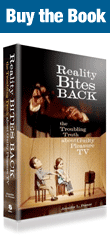Media Literacy: Fun for the Whole FamilyI dedicated Reality Bites Back to two of the savviest, most insightful people I know… who just happen to be five and six years old. Here’s what the dedication says:
From cable news to Dr. Phil, we’re regularly bombarded with scare-tactic stories about how The Media Are Hopelessly Corrupting Our Impressionable Youth!!! While media do have an undeniable impact on all of us—kids as well as adults—this narrative often underestimates the intelligence of young people and denies their ability to question, interpret, and resist problematic messages in news and pop culture. Media literacy strategies can help kids do just that. As parents, siblings, teachers, and friends, we have to get beyond condescending or judging the media that girls and boys identify with and enjoy. Instead, it’s up to us to pay attention to the TV they’re watching, the social media they’re interacting with, the video games they’re playing, and the music they’re listening to. Interact, play, listen, and watch with them. Talk with them about what they’re learning from these forms of media, how they feel about their favorite musicians, actors, TV shows, movies, magazines, and websites, and how they feel about themselves when (and after) they engage with these media. For these ongoing conversations to be met with anything other than an eye roll, they should be both fun and youth-led. Create a safe space that allows kids to investigate and decode media for themselves. Don’t lecture; listen and ask questions. You may be the expert in life experience, but kids are the experts in the media that surround them. I don’t believe parents should forbid their kids from watching all TV. Not only will that make them want to watch it more when you’re not around, it also leaves them vulnerable to deception and bias in advertising and media. It is much healthier to watch with them and talk with them about what they’re seeing—on a regular basis. That said, limiting the number of hours of media consumption per day is a healthy practice—and television may not be appropriate for extremely young children who have not gone through the developmental stages necessary to decipher truth from fiction, reality from representation. Any of the games in this chapter can be adapted for younger kids. With access to a VCR, a DVR, or online video, they can make their own Mad Libs based on recorded episodes of their favorite shows. Reality TV drinking games can be kid-friendly if you ditch the liquor and have the kids come up with the game rules: Maybe instead of taking a drink, they jump up and do a silly dance, or they choose a treat of some kind. During Backlash Bingo games, every time kids check off a square on their card, they get a prize—for example, a piece of sidewalk chalk. At the end of the game (and the show), they can draw a mural responding to what they’ve just seen. Or, take an example from family TV nights at Dr. Natalie Wilson’s house. A women’s studies professor, she plays “reality TV charades†with her son and daughter: “As we watch American Idol or So You Think You Can Dance, we observe the inane comments of the judges (particularly in relation to any sexist, anti-fat, racist, etc.)†and then act out role-playing scenes “mocking the close-mindedness of the judges.†After her daughter coined the term “boob crack†to refer to cleavage, they came up with “The Boob-Crack and Six-Pack Gameâ€: each player makes a “list of overt displays of cleavage and six packs†that appear on a show they’re watching. “This game leads to useful discussions of how female bodies are far more likely to appear less clothed and why,†Wilson notes. They also keep a running score of how often nonwhite, nonheterosexual contestants win competition series. “We have noticed that people who are disabled, fat, or do not accord to normative gender standards are most likely to NOT win. Thus, whenever we see such contestants, we cheer them on and celebrate with some candy, popcorn, or loud cheers.†Be creative, be open, and help foster an environment in which critical thinking isn’t a buzzkill, but a natural instinct. |






